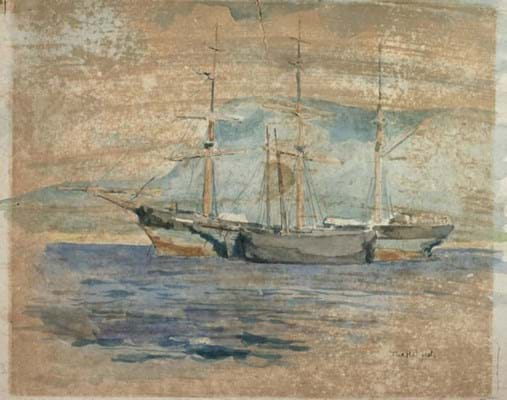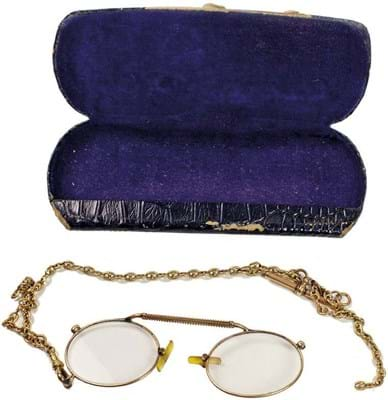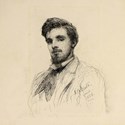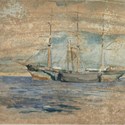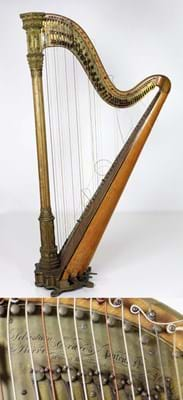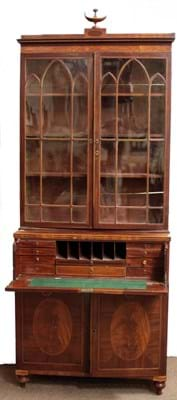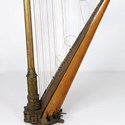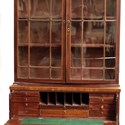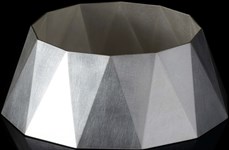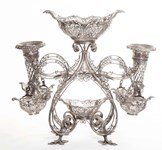Amid protests from the Irish culturati, the pick of the material was offered in 224 lots at Sotheby’s in September, garnering some £2m (ATG No 2311).
At Kilkenny auctioneers Fonsie Mealy (20% buyer’s premium) on November 14, amid considerably less strife, the rest of the pieces from Cliff House, Dalkey, added a further €300,000 (£270,000).
All 200 of them – about a quarter of the Castlecomer sale – got away to a mixture of collectors and national institutions with keen bidding coming from the USA and Hong Kong.
The most significant lot for Yeats scholars – catalogued as a major discovery – was a small morocco-bound pocket sketch book inscribed WB Yeats in the poet’s hand to the front inside cover.
Dating from his days at art college in Dublin (1884-85), it contained a few studies including a nude and a dozen head-and-shoulders portraits which experts say show he would have been a competent artist if he had persevered.
On the other hand, contemporary experts may equally have thought he should give up on poetry.
His draft for a poem called The Field Mouse reads: ‘The field mouse running yonder has reared up / No pyramid of custom or of laws / to break her heart / No, she is angry sometimes and she loves / The shadow of the wheat sheaves, that is all / The history of her life.’
No challenge to Rabbie Burns at that point then.
However, as one of only two such notebooks known to survive, it was, said the auctioneers “a significant and fascinating record of Yeats’ time as a young student a time when the world was full of opportunity”.
Bidders appeared to concur and, against a €3000-5000 estimate, the book sold at €17,000 (£15,315).
Family portrait
Yeats’ father, John Butler Yeats, was a decent, if often broke, portrait painter and the sale included a number of his works of family and friends.
By some way, the most expensive was the 1866 pen and ink portrait of William which John B insisted adorn his son’s first publication, the dramatic poem Masada. Estimated at €4000-6000, the portrait, on a 9 x 9½in (23 x 24cm) card, sold at €21,000 (£18,920).
The great Yeats artist is, of course, brother Jack whose works have sold in seven figures.
At Castlecomer, however, his top seller was a signed 9 x 11in (22 x 28cm) watercolour of anchored ships, probably at Sligo, dated c.1883-84 when Jack was 12 or 13.
With some evidence of Jack’s innate talent, it was estimated at €300-500 and sold at €4200 (£3785).
Anything from the Provenance: The Yeats Family Collection label tended to demolish estimates.
Simply catalogued as ‘two cased violins/fiddles’ and estimated at €120-160, the nondescript instruments made €4500 (£4055).
A set of 79 tarot cards (plus one blank) were signed by Pamela Colman Smith, the American artist who became a friend of the Yeats family and who illustrated a book of William’s poems. The cards, along with a 1920 book The Key to Tarot made €4800 (£4325), 10 times the lower estimate.
Perhaps more understandably in an Irish context, a 19th century, 8ft 2in (2.48m) tall giltwood concert harp by London makers Sébastien & Pierce Érard, went at a six-times-estimate €11,000 (£9900).
The Dalkey home even put polish on brown furniture – and the family secretaire bookcase in particular.
It was in itself a fine Adams period piece in inlaid mahogany, standing 8ft 3in tall (2.51m) with a cornice surmounted by an urn, glass gothic doors and a fall with a fitted interior.
The €3000-5000 estimate on the Yeats family piece didn’t look too conservative. However, the knowledge that it had contained Yeats’ books and printed notepaper was enough to prompt it to sell at €9000 (£8110).
At the Sotheby’s sale, Yeats’ writing bureau, a nondescript Edwardian piece which might fetch £100 in a general sale, sold at £150,000.
Personal connection
For the personal-connection frenzy factor – akin to the guitar of a rock star – there was Yeats gilt-framed pince-nez. ‘See the world through the poet’s eyes’ urged the catalogue. One has to assume that bidding was not limited to those with the same opthalmic prescription as Yeats for the spectacles, estimated at €500- 600, sold at €10,000 (£9010).
An Edwardian, London-made silver desk inkwell from which, the auctioneers understood, had ‘flowed many wonderful compositions’, sold at €2900 (£2610).
Another reasonable catalogue conjecture concerned a high-quality leather briefcase with stencilled initials WBY in white, a further initial ‘M’ added before the ‘W’.
The auctioneers understood it to have been used by WB since about 1900 and that the M signified it was later used by Michael.
The cataloguers allowed themselves another flourish asking ‘who can say what poems and papers it once carried?’ and pitched it at €600-800. It sold at €3400 (£3065).
The sale was the final chapter in the Yeats family collection which, including sales to the States, has brought the vendors more than €6m (£5.40m).
£1 = €1.11



